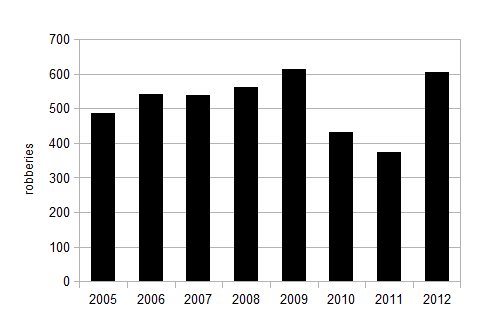Yet another bogus crime wave
This is becoming an
annual event: somebody shouts “crime wave!”, based on a
simple comparison of this year versus last year, and if this year's
crime count is higher, then bingo, you've got a crime wave.
Last year it was the
Washington Post with a burglary
surge. This year, it's the Washington Times, headlining
Violent
crime in D.C. surges in 2012. “Violent
crime so far this year has spiked sharply – a 40 percent
increase that includes twice as many robberies at gunpoint than at
this time last year”, they write, scarily. Continuing, “all
police districts are reporting increases in violent crime, and all
but one have had double-digit percentage increases, according to
internal Metropolitan Police Department documents”. Other news
media follow this lead, e.g., D.C.
police: Crime wave continues with more robberies in Northwest today.
Even the Guardian
Angels are out in force, handing out fear-crime
flyers at Metro stops.
Well – is this a
real “crime wave”, or is there a less frightening
explanation for these increases in crime? Here's one skeptic:
violent crime in the first six weeks of 2012 fits neatly into
long-term trends. Besides the “long-term
trends”, this skeptic observes that “Seasonal effects and
seemingly random events will trigger brief crime spikes and brief
crime declines”. And, further, “as crime rates return to
more typical levels, comparisons with an anomalously low
violent-crime period create the illusion of a crime spike”.
That's the thing –
if the earlier period was characterized by “anomalously low”
crime, then a comparison to this year will result in a “surge”,
even if this year's count is merely a return to normal. That was
certainly the case for the Washington Post's 2011 burglary wave,
comparing that year's wintertime count to the count during the winter
of 2010 – notorious as “Snowmaggedon”, when
everyone, including career criminals, was paralyzed by the deep snow.
 The
current “spike” in crime is based on this same mistake:
comparing this year to last year, implicitly assuming that last year
was a “normal” year. Such an assumption is always chancy,
but especially in winter, when weather can make a very large
difference.
The
current “spike” in crime is based on this same mistake:
comparing this year to last year, implicitly assuming that last year
was a “normal” year. Such an assumption is always chancy,
but especially in winter, when weather can make a very large
difference.
Here's a chart showing
the robbery counts, citywide, for the period January 1 through
February 22 (approximately, the period considered by the Washington
Times). Yes, the robbery count in 2012 is a lot larger than the count
in 2010 and 2011. But on the other hand, it's not much larger than
the 2009 count, and is consistent with the trend apparent in the
2005-2009 data.
What happened in 2010
and 2011? Quite simply, those were relatively harsh winters,
especially 2010, with a record 40 inches of snow in January and
February. In 2011, the snow totalled 8 inches, still enough to
paralyze Washington. But this year, 2012, has been a “winter”
characterized by nearly zero snow, and by balmy, record-high winter
time temperatures. Similarly, 2009 saw almost no snow.
In such mild-weather
conditions, people are out on the street, enjoying the unseasonably
warm weather, and some people will be seen strolling along with
smartphones out, their attention focused on whatever they're reading
or texting. That's an invitation for a snatch-and-run robbery, and
smartphones seem to be a favored target this year. In colder
wintertime weather, people spend as little time as possible outdoors,
and when they're out on the street, they're hurrying along to
whereever they're going, their smartphones safely tucked away in
pockets or purses. Plainly, the number of potential robbery targets
is much higher in good weather than in bad.
The current “spike”
in crime amounts merely to a comparison of a mild-weather winter to a
couple of harsh-weather winters. That's what the Post did last year,
for burglaries, and that's what the Times has done this year, for
robberies. The situation calls not for fear, and for hurling lots of
extra police at the problem, and Guardian Angels posted at Metro
stations, but for the caution that should be routine for city
dwellers.
Return to home
Page created February 27, 2012
 The
current “spike” in crime is based on this same mistake:
comparing this year to last year, implicitly assuming that last year
was a “normal” year. Such an assumption is always chancy,
but especially in winter, when weather can make a very large
difference.
The
current “spike” in crime is based on this same mistake:
comparing this year to last year, implicitly assuming that last year
was a “normal” year. Such an assumption is always chancy,
but especially in winter, when weather can make a very large
difference.